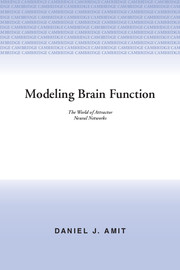Book contents
- Frontmatter
- Contents
- Preface
- Dedication
- 1 Introduction
- 2 The Basic Attractor Neural Network
- 3 General Ideas Concerning Dynamics
- 4 Symmetric Neural Networks at Low Memory Loading
- 5 Storage and Retrieval of Temporal Sequences
- 6 Storage Capacity of ANN's
- 7 Robustness - Getting Closer to Biology
- 8 Memory Data Structures
- 9 Learning
- 10 Hardware Implementations of Neural Networks
- Glossary
- Index
- Frontmatter
- Contents
- Preface
- Dedication
- 1 Introduction
- 2 The Basic Attractor Neural Network
- 3 General Ideas Concerning Dynamics
- 4 Symmetric Neural Networks at Low Memory Loading
- 5 Storage and Retrieval of Temporal Sequences
- 6 Storage Capacity of ANN's
- 7 Robustness - Getting Closer to Biology
- 8 Memory Data Structures
- 9 Learning
- 10 Hardware Implementations of Neural Networks
- Glossary
- Index
Summary
Philosophy and Methodology
Reduction to physics and physics modeling analogues
When physics ventures to describe biological or cognitive phenomena it provokes a fair amount of suspicion. The attempt is sometimes interpreted as the expression of an epistemological dogma which asserts that all natural phenomena are reducible to physical laws; that there is an intrinsic unity of science; that there are no independent levels or languages of description, only more or less detailed ones. The intent of this section is to allay such concern with regard to the present monograph, which remains neutral on the issue of reductionism. Yet, before explaining the conceptual alternative, of analogies to physical concepts, which has informed the work of physicists in the field of neural networks, it is hard to resist a few comments on the general issue of reductionism, as well as an expression of our own commitment.
It should be pointed out that the misgivings about reductionism cast many shadows. Biologists often still harbor traces of vitalism and feel quite uncomfortable at the thought that life, evolution or selection could be described by laws of physics and chemistry. Cognitive scientists resent both the reduction of cognitive phenomena to neurobiology[1,2] as well as to computer language[3]. A physicist who reads Fodor's proof of the impossibility of reduction between different levels of description should be troubled about the connection that was so ingeniously erected by Boltzmann and Gibbs between the macroscopic phenomena of thermodynamics and the underlying microscopic dynamics of Newton, Maxwell and Planck.
- Type
- Chapter
- Information
- Modeling Brain FunctionThe World of Attractor Neural Networks, pp. 1 - 57Publisher: Cambridge University PressPrint publication year: 1989
- 1
- Cited by



